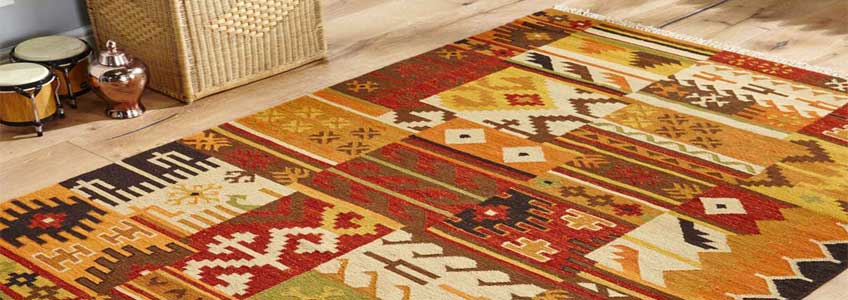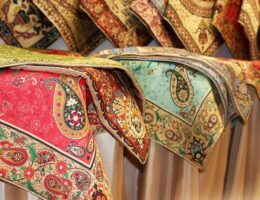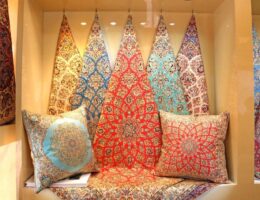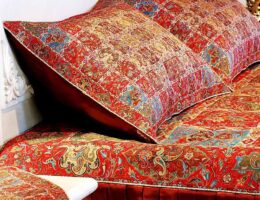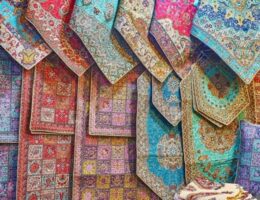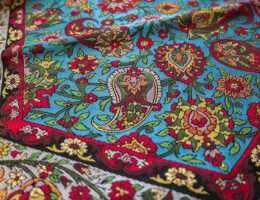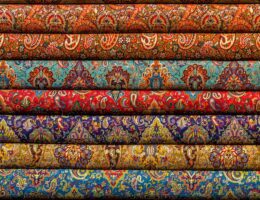IRAN ART EXHIBITION: A COMPLETE ANALYSIS OF PERSIAN CAERPET “GELIM”
KELIM (GELIM), a kind of flat-woven carpet employed by settled and nomadic families for a host of uses, primarily but not exclusively for covering household items and furnishing the interior of dwellings. Gelim is a term used in Persian-speaking parts of West Asia, especially in Iran, for large tapestry-woven textiles, also referred to as kilim in the Turkish speaking parts of West Asia.
Created mostly by women who have an eye for design and a great sense of color, gelims are prized for their rich color, diverse designs, their masterfully controlled weave structure, and their fine texture.
Structure and technique. All Persian flat-weaves, including gelims, have been woven either on horizontal (ru-zamini) or vertical (dāri, divāri) looms. A wide variety of flat-woven structures have been achieved by nomads and villagers throughout Iran by using this basic loom technology. The structure encountered on gelims is a form of plain weave referred to as tapestry weave (Sherrill, p. 851). The tapestry weave is an inherently limiting or restraining way of weaving to create curvilinear forms unless the weaver has the equipment, time, and skill in addition to material fine enough to do it correctly. Tapestry weave produces a simple textile structure in which one set of yarns called the weft (Pers. čella or tār) is interlaced horizontally with another set of yarns called the warp (Pers. pud) that are tautly stretched vertically on a loom. The weft interlacing occurs in regular intervals of over one warp yarn, then under one warp yarn, and creates a structure known as plain weave.
In tapestry weave, the weft yarns are solely responsible for the creation of design. This is achieved by a combination of two features. First, the weft yarns are not interlaced completely across the entire width of the textile; rather, they are worked back and forth only where their corresponding color is desired in the creation of a design. Another feature of tapestry weave is that the weft yarns are so tightly packed together during weaving that they completely cover the warp yarns, making only the weft yarns visible in the finished textile. These two features of tapestry weave have remained unchanged since antiquity. Tapestry weave produces the same design on both sides of a textile. Depending on function and/or tradition, some weavers carefully conceal the excess weft yarn ends and manipulate discontinuous wefts to create different color and textual effects such as eccentric weft.
Based on the relationship between different colored discontinuous weft yarns, tapestry weave can be divided into four technical groups: slit, dovetailed, single-interlocked, or double-interlocked tapestry weave (see Sherrill, Figs. 78-82). In slit tapestry weave, color change occurs when two different-colored yarns turn around the last warp yarn of their respective color areas. In other words, the adjoining warp yarns are not bound together. This creates a hole between the adjoining warp yarns called a slit. Slits, especially if they are too long, create very weak fabric, which is prone to tear. In response to this technical difficulty, weavers create designs to minimize long slits. Because of this technical constraint, the gelim designs do not feature continuous vertical lines. If a vertical line is necessary, the weaver uses a crenelated line.
The horizontal design changes can also be achieved when respective weft yarns turn around a common warp yarn, preventing the formation of slits. This structure is called dovetailed tapestry weave. Although the resulting fabric is stronger and more durable, outlines of the designs are blurred and it is hard to create crisp color changes.
IRAN ART EXHIBITION: In single interlock tapestry weave, weft yarn of one color loops around the adjacent weft yarn of other color. In double-interlocked tapestry weave, weft yarns are wrapped around each other in pairs, forming an even closer joint. Where the colors areas meet, if the weavers do the looping of the different colored weft yarns on the same face of the fabric, the one face of the textile looks smooth, while a ridge is formed on the other side, creating a fabric with a distinct front and back. Both single- and double-interlocked tapestry weave allow designs with vertical lines, in contrast to slit tapestry weave (Burnham, pp. 144-49; Emery, pp. 78-82; Mallett; Sherrill, pp. 851-52; Tanavoli, 2002, pp. 46-50; Wertime, 1979, pp. 53-55).
Gelims of the 16th and 17th centuries. Textiles from Iran have been famous since antiquity and have been praised by many. Nonetheless, not a single confidently dateable gelim from the Islamic era, prior to the 16th century, has survived to the present day. The earliest surviving gelims date from the 16th and 17th centuries to the period when the Safavid dynasty was at its height of power.
These gelims have distinct characteristics that set them apart from the 18th and 19th century examples. The undeniable reason for this distinction is that the surviving 16th- and 17th-century gelims were woven under Safavid court control. They are considered the finest examples of tapestry weave. They have superbly drawn designs and were splendidly executed in silk and metallic wrapped threads (Bier, pp. 212-13, Tanavoli, 2002, pp. 42-46; Walker, 2006, pp. 87-89). Their designs are in the classical Safavid court art style and were definitively created by the artists working for Shah Ṭahmāsp I (1524-76) and Shah ʿAbbās I (1588-1629). The figural representations, including exotic or imaginary animals, hunting scenes, arabesques, inscriptions, and myriad complex floral designs, are the hallmark of the Safavid court art and, by extension, these gelims. The designs most likely were provided to the weavers in the form of detailed cartoons drawn by court artists who excelled in manuscript illuminations. One technical aspect that separates these gelims from many later examples is that they were woven using single interlocked and dovetailed tapestry weave rather than slit tapestry weave.
There is debate about the production center or centers of this style of gelim. Considering that there are too many stylistic, iconographic, and technical variations among all surviving examples to support a common-origin theory, Kashan, Isfahan, and Tabriz are all presented as possible centers for their production. There are surviving gelims with the coat-of-arms of Sigmund III, King of Poland (1587-1632), which were woven in Kashan (Bier, pp. 230-31). There was also a royal workshop in Isfahan, which was the capital of Shah ʿAbbās I. In addition to these two centers, there are a few surviving gelims of this style that bear inscriptions pointing to Tabriz as their production centers. Until proven otherwise, the consensus among scholars at this point is that the production of these luxurious and expensive gelims was not restricted to a single workshop or to one center, but rather, they were produced in many centers in Iran. Classical Safavid court style was much imitated and copied in later centuries with varying degrees of success; on the other hand, the production of high quality gelims had ceased by the early 17th century (Walker, in EIr, IV, p. 871).
Gelims of the 18th and 19th centuries. A large body of surviving Persian gelims today consists of the so-called tribal gelims woven by women in nomadic encampments or homes in villages and towns. They have a predominantly geometric repertoire of motifs, some of which are extremely stylized versions of the classical Safavid court style motifs; but a great majority of them have origins in Turkic ornaments. This is not surprising considering many tribal groups who were and are weaving gelims in Iran are in fact of Turkic origin. There are no surviving examples of tribal gelims that pre-date the 18th century, thus it is not possible to state with total confidence that tribal gelims were being woven at the same time as the Safavid court-style gelims were made. But examining the quality of workmanship, sophistication, and diversity of designs in the gelims of the 18th and 19th centuries, it is easy to posit that there was gelimweaving in nomadic encampments, towns, and villages before the 18th century.
IRAN ART EXHIBITION: Gelim weaving has been practiced throughout Iran in one form or another, but the majority of gelims appears to come from centers on the northwest, north, east, and southeastern parts of the country, a region stretching from Southern Caucasus along the Zagros mountains to the Fārs region by the Persian Gulf.
The gelims of Iranian Azerbaijan show a close relationship to the gelims of the Azerbaijanis’ northern neighbors in the Caucasus. One difference is that those from Iran have more lustrous wool and slightly different colors. The designs are also more monumental and each individual motif stands alone, although still organized in bands. Gelims from Bijār (south of Tabriz), Qazvin (q.v.), and Zarand (east of Tehran) have the distinction of having cotton warp yarns and thicker wool wefts. Bijār and Qazvin gelims were woven in slit tapestry weave, while Zarand gelims were woven using dovetailed tapestry weave with eccentric weft weaving, which is the main distinguishing feature of Zarand gelims. Otherwise all three gelim weaving centers share the same design repertoire. This indicates that although Zarand weavers can weave designs with prominently vertical lines, they instead prefer to use the slit tapestry weave designs seen on gelims of Bijār and Qazvin (Azadi; Petsopoulos, pp. 282-95, 320-22; Tanavoli, 2002, pp. 50-93, 123-32).
Another group of gelims from northwestern Iran, known as “Ṭāleš” gelims, is thought to have been woven in the mountainous regions between Lenkoran (Lankarān) and Rašt, overlooking the Caspian Sea. The distinguishing feature of these gelims is that they are woven with very soft wool and have mellow coloration (Azadi; Petsopoulos, pp. 292-96).
While many of the gelims from the northwestern part of Iran have been associated with Turkic people, a good number of those from western Iran have been woven by Kurdish people. Many of these groups are settled in towns. The weavers produce well-balanced, orderly but dynamic compositions in slit tapestry weave. The most famous of this group of gelims were the ones woven in the city of Sanandaj. These gelims, generally small in size, are extremely finely woven with very thin, soft wool yarns creating minute repeat motifs. They are the only gelims with designs that relate to textiles of the Safavid style. The small and very delicate repeat patterns remind one of Safavid fabrics. To achieve the fineness and create delicate curvilinear forms, weavers often used eccentric weft weaving. Among the gelims woven in Iran, only Sanandaj gelims have the strong similarities in composition and design to Persian pile carpets (Azadi; Bier, pp. 270-71, 275; Petsopoulos, pp. 300-310; Tanavoli, 2002, pp. 94-106).

IRAN ART EXHIBITION: Simple, restrained ornamentation set a group of gelims woven by the Baḵtiāri apart from any other gelims woven in Iran. The Baḵtiāri, settled around Šuštar on the western side of the Zagros Mountains in southwestern Iran, wove gelims with camel hair. Besides camel hair in its light brown natural color as well as dyed blue, which is a feature unique to these gelims, the weavers used wool and cotton. The composition is one that plays with spatial relationship. The borders and the field are superimposed and almost float on a plain surface. Another distinguishing characteristic of these gelims is their use of double-interlocked tapestry weave. The rest of the Baḵtiāri gelims were woven by the nomadic groups on the eastern skirts of the Zagros Mountains overlooking Isfahan. Like the Šuštar gelims, these gelims were woven in double interlocked tapestry weave, but woven tighter, producing stiffer fabric that can withstand heavy wear and tear (Azadi; Ittig; Franchis and Wertime, pp. 18, 25-27, pls. 39-51; Petsopoulos, pp. 311-19; Tanavoli, 2002, pp. 162-73).
Varāmin, a town southeast of Tehran, is an important gelim-weaving center. Due to its location in the center of east-west migration routes, the population of the town is diverse, which in turn is reflected in the residents’ weavings, especially designs. The most distinguishing technical feature of gelims from Varāmin area is the presence of narrow bands in weft-float weaves forming S-shaped forms as design. This technique is most frequently seen in weavings of the Baluch in eastern Iran (Azadi; Petsopoulos, pp. 328-32; Tanavoli, 2001, pp. 15-17, 36-52; Tanavoli, 2002, pp. 133-38; see also BALUCHISTAN v. BALUCH CARPETS).
The majority of gelims from southern Iran are thought to have been woven by the Qašqāʾi tribe, although they are just one of the many nomadic or settled tribes of Fars. Many gelims were marketed through Shiraz, the largest and the official center of the province, and, therefore, known as such. The designs of gelims from the region vary. They include: small squares with serrated sides that are arranged chromatically or geometrically; many parallel stepped bands organized to create big diamond forms; diamond lattice compositions, each diamond filled with smaller motifs of various shapes; and finally, horizontal bands filled with repeat motifs of octagons, hexagons, squares, or stars (Azadi; Petsopoulos, pp. 333-79; Tanavoli, 2002, pp. 133-38.)
Persian carpet is one of the oldest Isfahan Gabbeh & Gilims or Persian rug is a heavy textile, made for a wide variety of utilitarian and symbolic purpose, produced in Iran for home use, local sale and export. Carpet weaving is an essential part of Persian culture and Iranian art. Iran use some materials for their carpets such as wool, cotton and silk. That Produced in workshops and homes in various cities of Iran such as Isfahan, Mashhad, Shiraz Nayin. In this article, the reader is introduced to different types of rugs in Iran.
Gabbeh
IRAN ART EXHIBITION: Gabbeh is a hand-woven rug characterized by an abstract design that relies upon field of color and a playfulness with geometry. The Gabbeh is usually crafted by women. Gabbeh carpets are much thicker and coarser than other Persian carpets. Gabbeh are made of natural, handspun wool yarn and all the colors are crafted with natural plant dye. Due to it’s less precise pattern, small number of knots. A Gabbeh is one of the less expensive varieties of Persian carpet. The patterns of the carpet are of a simple type with only few elements of decorative, mostly rectangular objects containing animals.
